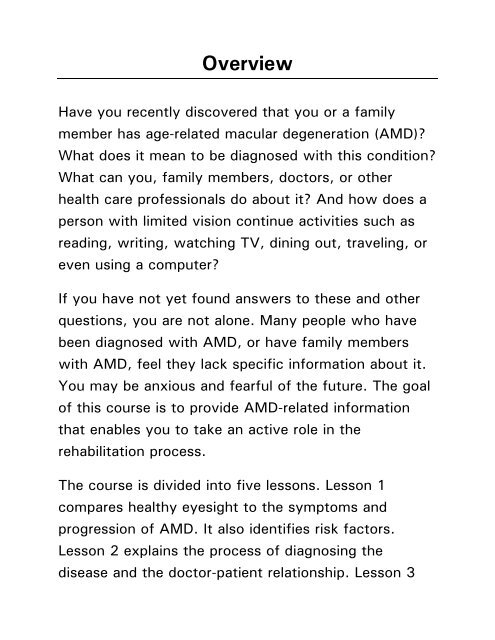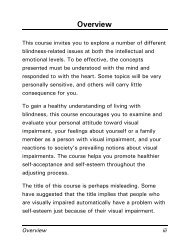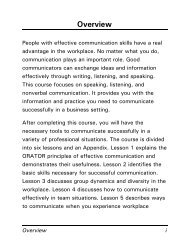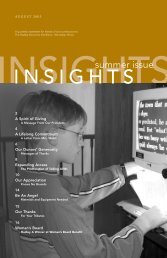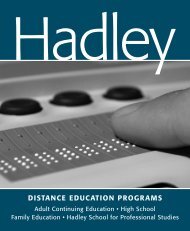View Sample Lesson in PDF Format - The Hadley School for the Blind
View Sample Lesson in PDF Format - The Hadley School for the Blind
View Sample Lesson in PDF Format - The Hadley School for the Blind
You also want an ePaper? Increase the reach of your titles
YUMPU automatically turns print PDFs into web optimized ePapers that Google loves.
Overview<br />
Have you recently discovered that you or a family<br />
member has age-related macular degeneration (AMD)<br />
What does it mean to be diagnosed with this condition<br />
What can you, family members, doctors, or o<strong>the</strong>r<br />
health care professionals do about it And how does a<br />
person with limited vision cont<strong>in</strong>ue activities such as<br />
read<strong>in</strong>g, writ<strong>in</strong>g, watch<strong>in</strong>g TV, d<strong>in</strong><strong>in</strong>g out, travel<strong>in</strong>g, or<br />
even us<strong>in</strong>g a computer<br />
If you have not yet found answers to <strong>the</strong>se and o<strong>the</strong>r<br />
questions, you are not alone. Many people who have<br />
been diagnosed with AMD, or have family members<br />
with AMD, feel <strong>the</strong>y lack specific <strong>in</strong><strong>for</strong>mation about it.<br />
You may be anxious and fearful of <strong>the</strong> future. <strong>The</strong> goal<br />
of this course is to provide AMD-related <strong>in</strong><strong>for</strong>mation<br />
that enables you to take an active role <strong>in</strong> <strong>the</strong><br />
rehabilitation process.<br />
<strong>The</strong> course is divided <strong>in</strong>to five lessons. <strong>Lesson</strong> 1<br />
compares healthy eyesight to <strong>the</strong> symptoms and<br />
progression of AMD. It also identifies risk factors.<br />
<strong>Lesson</strong> 2 expla<strong>in</strong>s <strong>the</strong> process of diagnos<strong>in</strong>g <strong>the</strong><br />
disease and <strong>the</strong> doctor-patient relationship. <strong>Lesson</strong> 3
provides <strong>in</strong><strong>for</strong>mation about how to maximize vision.<br />
<strong>Lesson</strong> 4 suggests ways to cont<strong>in</strong>ue accustomed<br />
activities. <strong>Lesson</strong> 5 discusses <strong>the</strong> emotional impact of<br />
AMD. A resource list <strong>in</strong>cludes sources of fur<strong>the</strong>r<br />
<strong>in</strong><strong>for</strong>mation, vision aids, and read<strong>in</strong>g materials. A<br />
supplement describes current treatments and research.<br />
You do not need any prerequisites to beg<strong>in</strong> this course.<br />
You do need <strong>the</strong> materials that <strong>The</strong> <strong>Hadley</strong> <strong>School</strong> <strong>for</strong><br />
<strong>the</strong> Bl<strong>in</strong>d has provided and writ<strong>in</strong>g materials <strong>in</strong> <strong>the</strong><br />
medium of your choice. If you are tak<strong>in</strong>g <strong>the</strong> audio<br />
version of <strong>the</strong> course, you need your own tape<br />
recorder.<br />
<strong>The</strong> reviews that follow each section are <strong>for</strong> your<br />
personal development only. Use <strong>the</strong>m as<br />
comprehension checks by compar<strong>in</strong>g your responses to<br />
<strong>the</strong> ones provided. Do not send your responses to your<br />
<strong>Hadley</strong> <strong>in</strong>structor. You can always contact your<br />
<strong>in</strong>structor, however, to clarify concepts or discuss your<br />
answers. To do so, refer to <strong>the</strong> contact <strong>in</strong><strong>for</strong>mation<br />
card that is <strong>in</strong>cluded with your course materials.<br />
To complete <strong>the</strong> course, you are required to submit five<br />
assignments, one at <strong>the</strong> end of each lesson. <strong>The</strong>se<br />
assignments enable your <strong>in</strong>structor to assess your
mastery of <strong>the</strong> material <strong>in</strong> <strong>the</strong> lessons. You can mail,<br />
fax, or email your assignments to your <strong>in</strong>structor. If<br />
mail<strong>in</strong>g <strong>the</strong>m, use <strong>the</strong> enclosed labels. <strong>The</strong> enclosed<br />
contact card lists your <strong>in</strong>structor’s fax number and<br />
email address. Students who are eligible to mail<br />
materials as Free Matter <strong>for</strong> <strong>the</strong> Bl<strong>in</strong>d may do so<br />
provided <strong>the</strong> materials are <strong>in</strong> large pr<strong>in</strong>t or on cassette<br />
or computer disk. <strong>The</strong> m<strong>in</strong>imum size <strong>for</strong> large pr<strong>in</strong>t is<br />
14-po<strong>in</strong>t type.
<strong>Lesson</strong> 4: Cont<strong>in</strong>u<strong>in</strong>g Accustomed<br />
Activities<br />
Can a person with low vision d<strong>in</strong>e out, travel, read, and<br />
watch television Realistically, <strong>in</strong>dividuals with low<br />
vision do have to make adjustments, and <strong>in</strong> some cases<br />
cease to do certa<strong>in</strong> activities. But it would be a mistake<br />
<strong>for</strong> a person with advanced stage AMD to stay at home<br />
all <strong>the</strong> time and elim<strong>in</strong>ate all of his or her activities.<br />
<strong>Lesson</strong> 1 compared healthy eyesight to <strong>the</strong> effects of<br />
AMD, and it listed some risk factors. <strong>Lesson</strong> 2<br />
expla<strong>in</strong>ed AMD diagnosis and <strong>the</strong> doctor-patient<br />
relationship. <strong>Lesson</strong> 3 described methods and devices<br />
that help people use <strong>the</strong>ir rema<strong>in</strong><strong>in</strong>g vision to <strong>the</strong> fullest<br />
extent possible. This lesson discusses ways to cont<strong>in</strong>ue<br />
accustomed activities. Cont<strong>in</strong>u<strong>in</strong>g accustomed<br />
activities, or help<strong>in</strong>g a family member to do so, will<br />
enable you to take an active role <strong>in</strong> <strong>the</strong> rehabilitation<br />
process.<br />
Objective<br />
After complet<strong>in</strong>g this lesson, you will be able to discuss<br />
cont<strong>in</strong>u<strong>in</strong>g many activities with AMD.
Lifestyle Adaptations With Low Vision<br />
This lesson discusses <strong>the</strong> follow<strong>in</strong>g activities:<br />
• driv<strong>in</strong>g and travel<strong>in</strong>g<br />
• read<strong>in</strong>g, writ<strong>in</strong>g, and o<strong>the</strong>r close work<br />
• home life<br />
• employment and computer use<br />
• sports and enterta<strong>in</strong>ment<br />
• d<strong>in</strong><strong>in</strong>g and socializ<strong>in</strong>g<br />
If you are aware of o<strong>the</strong>r activities that are becom<strong>in</strong>g<br />
challeng<strong>in</strong>g due to low vision, consult with a low vision<br />
specialist. Also, use <strong>the</strong> Resource List <strong>in</strong>cluded with<br />
your course materials <strong>for</strong> <strong>in</strong><strong>for</strong>mation on some of <strong>the</strong><br />
types of aids mentioned <strong>in</strong> this lesson. For more<br />
suggestions concern<strong>in</strong>g liv<strong>in</strong>g well with low vision and<br />
bl<strong>in</strong>dness, refer to <strong>the</strong> Resource List and <strong>the</strong> <strong>Hadley</strong><br />
<strong>School</strong> Course Catalog.<br />
Driv<strong>in</strong>g and Travel<strong>in</strong>g<br />
If you live anywhere o<strong>the</strong>r than <strong>in</strong> a big city, you are<br />
probably accustomed to driv<strong>in</strong>g a car wherever you<br />
need to go. Giv<strong>in</strong>g up driv<strong>in</strong>g can <strong>the</strong>re<strong>for</strong>e be a major<br />
decision. Most people today have been driv<strong>in</strong>g s<strong>in</strong>ce<br />
<strong>the</strong>ir late teens, so a driver’s license has become a
symbol of maturity and <strong>in</strong>dependence. Giv<strong>in</strong>g it up can<br />
be an emotional hurdle.<br />
To determ<strong>in</strong>e whe<strong>the</strong>r a person should discont<strong>in</strong>ue<br />
driv<strong>in</strong>g, first f<strong>in</strong>d out whe<strong>the</strong>r he or she can legitimately<br />
hold a driver’s license. Each locality, whe<strong>the</strong>r state,<br />
prov<strong>in</strong>ce, or country, has m<strong>in</strong>imum vision standards <strong>for</strong><br />
driv<strong>in</strong>g. Some states give restricted driver’s licenses to<br />
people with low visual acuity. Generally, this means<br />
driv<strong>in</strong>g only <strong>in</strong> daylight, with<strong>in</strong> a certa<strong>in</strong> radius, and on<br />
specific types of roads.<br />
It often happens that a person with early stage AMD<br />
puts off gett<strong>in</strong>g an eye exam <strong>for</strong> fear that he or she will<br />
not pass <strong>the</strong> state licens<strong>in</strong>g requirements. And because<br />
many states require test<strong>in</strong>g only once every two years,<br />
it’s easy to keep a license even after vision has<br />
deteriorated beyond legal limits.<br />
It is dangerous to drive with limited vision. If you have<br />
AMD, you probably wonder if you would lose your<br />
<strong>in</strong>dependence by giv<strong>in</strong>g up your license. Th<strong>in</strong>k, though,<br />
how easily accidents happen, even around your home.<br />
Would you be endanger<strong>in</strong>g yourself or o<strong>the</strong>rs by<br />
cont<strong>in</strong>u<strong>in</strong>g to drive Weigh <strong>the</strong> risk of serious <strong>in</strong>jury
aga<strong>in</strong>st <strong>the</strong> possible <strong>in</strong>convenience of f<strong>in</strong>d<strong>in</strong>g alternative<br />
transportation.<br />
If you have a family member who you believe should<br />
not be driv<strong>in</strong>g, first check <strong>the</strong> vision requirements <strong>for</strong><br />
your locality. Arrange a time <strong>for</strong> an open, frank<br />
conversation with your family member. Plan carefully<br />
exactly when you will address this with an <strong>in</strong>dividual,<br />
because tim<strong>in</strong>g is very important. For example, when<br />
people are rushed, tired, or hungry, it’s difficult to<br />
address emotional matters. Po<strong>in</strong>t out <strong>the</strong> difference<br />
between <strong>the</strong> legal requirements and <strong>the</strong> <strong>in</strong>dividual’s<br />
current visual acuity. Listen respectfully to your loved<br />
one. He or she should feel free to express some<br />
distress and even anger about <strong>the</strong> possible loss of<br />
<strong>in</strong>dependence. Describe alternative transportation<br />
options, such as buses, taxicabs, and rides from friends<br />
and family. Be honest; don’t downplay <strong>the</strong><br />
<strong>in</strong>convenience factor. And when <strong>the</strong> person decides to<br />
stop driv<strong>in</strong>g, praise him or her <strong>for</strong> be<strong>in</strong>g wise and<br />
courageous.<br />
Some people may ask about <strong>the</strong> use of bioptic glasses<br />
<strong>for</strong> driv<strong>in</strong>g. Eye doctors and general practitioners, as<br />
well as occupational <strong>the</strong>rapists, can work toge<strong>the</strong>r to
assess whe<strong>the</strong>r driv<strong>in</strong>g with bioptics is recommended.<br />
<strong>The</strong>y evaluate <strong>the</strong> <strong>in</strong>dividual’s general health,<br />
medications, color vision, glare sensitivity, reaction<br />
ability, and previous driv<strong>in</strong>g experience. Many states,<br />
prov<strong>in</strong>ces, and countries allow people us<strong>in</strong>g bioptics to<br />
hold a restricted license.<br />
What about travel<strong>in</strong>g by o<strong>the</strong>r means: bus, tra<strong>in</strong>, or air<br />
Central vision loss makes it difficult to identify bus<br />
numbers, tra<strong>in</strong> plat<strong>for</strong>m and plane gate numbers, and<br />
directional signs. Whe<strong>the</strong>r visit<strong>in</strong>g people or<br />
experienc<strong>in</strong>g new places, anyone can enjoy <strong>the</strong> journey<br />
with a few special tools and a positive attitude. Plan <strong>for</strong><br />
more time at every stage of <strong>the</strong> trip. Once you’re at a<br />
station or airport, ask <strong>for</strong> help, or arrange with <strong>the</strong><br />
airl<strong>in</strong>e, bus l<strong>in</strong>e, or railway <strong>for</strong> assistance <strong>in</strong> advance.<br />
Be<strong>for</strong>e <strong>the</strong> trip, practice or help your family member to<br />
practice us<strong>in</strong>g whatever tools a low vision specialist<br />
has recommended. <strong>The</strong>se may <strong>in</strong>clude various types of<br />
handheld or attached telescopes <strong>for</strong> see<strong>in</strong>g gate<br />
numbers and signs.<br />
You’ll probably want to tour <strong>the</strong> area you’re visit<strong>in</strong>g. Be<br />
prepared to get close to objects you’re <strong>in</strong>terested <strong>in</strong>,<br />
such as pa<strong>in</strong>t<strong>in</strong>gs or plants. Ask whe<strong>the</strong>r you can touch
exhibits. Skip those types of tours that would be<br />
mean<strong>in</strong>gless. If you are accompany<strong>in</strong>g a family member<br />
with low vision, adjust to a slower pace, describe <strong>the</strong><br />
surround<strong>in</strong>gs, and have an upbeat approach to each<br />
adventure.<br />
Read<strong>in</strong>g, Writ<strong>in</strong>g, and O<strong>the</strong>r Close Tasks<br />
If you or a person you know beg<strong>in</strong>s to have difficulty<br />
with close tasks, <strong>the</strong> first th<strong>in</strong>g to do is <strong>in</strong>crease <strong>the</strong><br />
light<strong>in</strong>g. People with AMD need about three times as<br />
much light as do those with healthy vision. This section<br />
discusses task light<strong>in</strong>g. <strong>The</strong> next section, Home Life,<br />
<strong>in</strong>cludes <strong>in</strong><strong>for</strong>mation about general room light<strong>in</strong>g. Much<br />
of <strong>the</strong> <strong>in</strong><strong>for</strong>mation presented here applies to both types<br />
of light<strong>in</strong>g. You can <strong>in</strong>crease <strong>the</strong> amount of light <strong>in</strong> a<br />
number of ways as follows:<br />
• Increase <strong>the</strong> wattage of <strong>the</strong> bulb, but only if <strong>the</strong><br />
lamp is designed <strong>for</strong> higher wattage. For example,<br />
us<strong>in</strong>g a 100-watt bulb <strong>in</strong> a lamp designed <strong>for</strong> a 60-<br />
watt bulb can cause a fire.<br />
• Use a different k<strong>in</strong>d of bulb. Experiment to f<strong>in</strong>d out<br />
which works best <strong>for</strong> you. Three types of bulb<br />
exist: <strong>in</strong>candescent, fluorescent, and halogen. Each<br />
of <strong>the</strong>se comes <strong>in</strong> vary<strong>in</strong>g wattages and styles.<br />
Fixtures are usually designed to take certa<strong>in</strong> k<strong>in</strong>ds
of bulbs. Incandescent bulbs are <strong>the</strong> cheapest. <strong>The</strong><br />
higher <strong>the</strong> wattage, however, <strong>the</strong> more heat <strong>the</strong>y<br />
produce. Fluorescent bulbs are more expensive.<br />
But <strong>the</strong>y demand less electricity to produce <strong>the</strong><br />
same amount of light as an <strong>in</strong>candescent bulb, and<br />
<strong>the</strong>y generate less heat. Some fluorescent bulbs<br />
labeled “full spectrum” do not produce glare;<br />
conventional ones often do. Halogen bulbs produce<br />
an <strong>in</strong>tense light, but <strong>the</strong>y also give off a lot of heat.<br />
• Try a full spectrum lightbulb. Though <strong>the</strong>y’re more<br />
expensive than regular bulbs, many people are<br />
conv<strong>in</strong>ced that <strong>the</strong>y see better with bulbs that<br />
simulate true daylight.<br />
For read<strong>in</strong>g and close tasks, adjust<strong>in</strong>g <strong>the</strong> bl<strong>in</strong>ds or<br />
curta<strong>in</strong>s can make a big difference. In addition,<br />
rearrang<strong>in</strong>g <strong>the</strong> furniture so that your back is to <strong>the</strong><br />
w<strong>in</strong>dow allows <strong>the</strong> light to fall over your shoulder<br />
ra<strong>the</strong>r than directly on your face.<br />
Task light<strong>in</strong>g is best aimed below <strong>the</strong> level of your<br />
eyes, illum<strong>in</strong>at<strong>in</strong>g your work or project directly. Task<br />
lamps have a covered bulb with a gooseneck or h<strong>in</strong>ge<br />
connection to <strong>the</strong> base so <strong>the</strong>y are adjustable. Also,<br />
you can easily carry a small task light from place to
place <strong>in</strong> <strong>the</strong> home. <strong>The</strong>rapists suggest aim<strong>in</strong>g <strong>the</strong> light<br />
at an angle so that <strong>the</strong> light falls on your work but<br />
bounces away from you. Use a dark tablecloth or<br />
blotter on your work surface to reduce glare.<br />
A person with low vision can f<strong>in</strong>d most read<strong>in</strong>g<br />
materials <strong>in</strong> large pr<strong>in</strong>t. Most libraries have a section of<br />
books <strong>in</strong> large pr<strong>in</strong>t. A few newspapers and magaz<strong>in</strong>es<br />
also appear <strong>in</strong> large pr<strong>in</strong>t. <strong>The</strong> Resource List <strong>in</strong>cludes<br />
sources of large pr<strong>in</strong>t read<strong>in</strong>g material. If you use a<br />
computer, pr<strong>in</strong>t material <strong>in</strong> large pr<strong>in</strong>t: 14-po<strong>in</strong>t<br />
typeface or larger. Choose a pla<strong>in</strong> style that does not<br />
have decorative l<strong>in</strong>es on <strong>the</strong> tops and bottoms of<br />
letters.<br />
For writ<strong>in</strong>g letters and sign<strong>in</strong>g checks, guides can be<br />
helpful. <strong>The</strong>se are plastic templates with spaces to be<br />
filled <strong>in</strong> over each area. Templates exist <strong>for</strong> writ<strong>in</strong>g<br />
checks and letters, and <strong>for</strong> address<strong>in</strong>g envelopes. A<br />
low vision <strong>the</strong>rapist can recommend templates, or you<br />
can f<strong>in</strong>d <strong>the</strong>m <strong>in</strong> low vision catalogs. Whe<strong>the</strong>r writ<strong>in</strong>g<br />
notes to yourself or a person with low vision, use a<br />
black felt-tip marker on a full-sized piece of white<br />
paper.
Home Life<br />
When a person’s vision beg<strong>in</strong>s to deteriorate, first<br />
<strong>in</strong>crease <strong>the</strong> general room light as much as possible.<br />
Sources of room light <strong>in</strong>clude both natural light from<br />
w<strong>in</strong>dows and artificial light. Direct sunlight through<br />
glass w<strong>in</strong>dows can produce a disturb<strong>in</strong>g amount of<br />
glare. Dark, heavy drapes, on <strong>the</strong> o<strong>the</strong>r hand, prevent<br />
natural light from enter<strong>in</strong>g. <strong>The</strong> best choice is a sheer<br />
curta<strong>in</strong> or an adjustable bl<strong>in</strong>d that allows light <strong>in</strong> but<br />
filters <strong>the</strong> glare.<br />
Artificial room lights <strong>in</strong>clude ceil<strong>in</strong>g fixtures, stand<strong>in</strong>g<br />
lamps, and table lamps. Some types of fixtures produce<br />
more glare than o<strong>the</strong>rs. For example, replac<strong>in</strong>g<br />
fluorescent fixtures with <strong>in</strong>candescent ones can reduce<br />
glare on your read<strong>in</strong>g or work.<br />
Lamps with shades are not a good choice <strong>for</strong> general<br />
room light<strong>in</strong>g. Traditional shades mute most of <strong>the</strong> light<br />
and funnel <strong>the</strong> rest, sometimes produc<strong>in</strong>g too much<br />
glare. Many people are happy to get rid of <strong>the</strong>m. A<br />
good choice is a torchiere style floor lamp, which<br />
throws light upward to reflect off <strong>the</strong> ceil<strong>in</strong>g. <strong>The</strong> result<br />
is a softer, glare-free illum<strong>in</strong>ation. Make sure, however,<br />
that <strong>the</strong> torchiere you select is safe. Halogen torchieres
have been known to set fires by ignit<strong>in</strong>g draperies or<br />
even an accumulation of dust.<br />
It’s important to keep everyth<strong>in</strong>g <strong>in</strong> <strong>the</strong> home organized<br />
when eyesight becomes poor. Everyone can work<br />
toge<strong>the</strong>r to make <strong>the</strong> home safe. To beg<strong>in</strong> with, always<br />
place items <strong>in</strong> <strong>the</strong> same place. Objects that are affixed<br />
to walls won’t be knocked over. For example, get an<br />
illum<strong>in</strong>ated magnify<strong>in</strong>g mirror with an extend<strong>in</strong>g arm,<br />
and bolt it to <strong>the</strong> wall. Toothbrush and soap holders <strong>in</strong><br />
<strong>the</strong> bathroom, as well as knife and utensil holders <strong>in</strong><br />
<strong>the</strong> kitchen, can also be permanently affixed to <strong>the</strong><br />
counter or wall.<br />
Contrast helps immensely <strong>in</strong> <strong>the</strong> home. Avoid us<strong>in</strong>g<br />
patterned tablecloths. Dark dishes on a light cloth are<br />
much easier to see than dishes on a similarly colored<br />
cloth. Similarly, dark-colored toothbrushes and<br />
hairbrushes show up on a light-colored vanity top. Keep<br />
a selection of mugs and cups <strong>in</strong> both light and dark<br />
colors. Pour dark-colored dr<strong>in</strong>ks like purple grape juice<br />
<strong>in</strong>to light-colored cups, and light-colored beverages like<br />
milk <strong>in</strong>to dark ones.<br />
Us<strong>in</strong>g <strong>the</strong> kitchen can become so frustrat<strong>in</strong>g when<br />
sight deteriorates that many people give up. With some
simple adaptations, however, food preparation and<br />
even enterta<strong>in</strong><strong>in</strong>g are not only possible but also<br />
enjoyable. Low vision catalogs list devices that enable<br />
those with low vision to measure, cut, chop, and stir<br />
successfully and safely. One simple solution <strong>for</strong> us<strong>in</strong>g<br />
<strong>the</strong> dials on <strong>the</strong> range and oven is to apply a thick<br />
stroke of enamel pa<strong>in</strong>t <strong>in</strong> a contrast<strong>in</strong>g color so that it<br />
<strong>for</strong>ms a raised marker. Low vision aids <strong>in</strong>clude special<br />
products that harden to <strong>for</strong>m a raised l<strong>in</strong>e or dot to<br />
<strong>in</strong>dicate <strong>the</strong> mark<strong>in</strong>gs.<br />
In o<strong>the</strong>r rooms, consider us<strong>in</strong>g telephones with large,<br />
illum<strong>in</strong>ated buttons and large clocks. “Talk<strong>in</strong>g” clocks<br />
are a good option. Use double-sided tape to ensure that<br />
carpets lie flat. Use approved holders to safely secure<br />
electric cords to <strong>the</strong> floor or walls. Use bright white or<br />
yellow tape to mark <strong>the</strong> edges of stair steps and any<br />
obstacles <strong>in</strong> <strong>the</strong> home.<br />
A person with advanced stage AMD may f<strong>in</strong>d it easier<br />
to see images on television when sitt<strong>in</strong>g close to <strong>the</strong><br />
screen. Rearrange furniture to make television view<strong>in</strong>g<br />
easier—perhaps by sett<strong>in</strong>g an armchair close to <strong>the</strong> set.
Sports and Enterta<strong>in</strong>ment<br />
<strong>The</strong> loss of central vision does not mean giv<strong>in</strong>g up<br />
physical exercise or cultural events. Indeed, regular<br />
physical exercise provides enormous health benefits.<br />
One suggestion <strong>for</strong> lower<strong>in</strong>g <strong>the</strong> risk of fur<strong>the</strong>r<br />
deterioration of <strong>the</strong> macula is to lower blood pressure<br />
and cholesterol levels. Regular exercise helps to<br />
accomplish <strong>the</strong>se goals. Cultural events take <strong>the</strong> m<strong>in</strong>d<br />
away from everyday frustrations and may help alleviate<br />
depression.<br />
Never<strong>the</strong>less, some accommodations may be needed. If<br />
a person enjoys tennis but can no longer see <strong>the</strong> ball<br />
clearly, he or she might try walk<strong>in</strong>g <strong>in</strong> parks or malls.<br />
Bowl<strong>in</strong>g is a good substitute, s<strong>in</strong>ce few if any<br />
adaptations are needed to cont<strong>in</strong>ue bowl<strong>in</strong>g. If loss of<br />
depth perception makes walk<strong>in</strong>g and runn<strong>in</strong>g outside<br />
dangerous, why not walk with a friend, use a treadmill<br />
or stationary bike, or swim Most fitness centers have<br />
tra<strong>in</strong>ers who suggest modifications that allow a person<br />
with low vision to enjoy exercise <strong>in</strong>doors and out.<br />
Stimulat<strong>in</strong>g <strong>the</strong> m<strong>in</strong>d is as important as exercis<strong>in</strong>g <strong>the</strong><br />
muscles. <strong>The</strong>re<strong>for</strong>e, take yourself or your family<br />
member out to events. You can appreciate music
concerts without see<strong>in</strong>g <strong>the</strong> per<strong>for</strong>mers. If gett<strong>in</strong>g<br />
around <strong>in</strong> a large auditorium becomes daunt<strong>in</strong>g, f<strong>in</strong>d<br />
per<strong>for</strong>mances <strong>in</strong> smaller venues. <strong>The</strong>atergoers can use<br />
wearable telescopes to follow <strong>the</strong> action. At a movie<br />
<strong>the</strong>ater, sitt<strong>in</strong>g close to <strong>the</strong> front makes it easier to see<br />
images on <strong>the</strong> screen. Attend<strong>in</strong>g lectures is ano<strong>the</strong>r<br />
<strong>for</strong>m of m<strong>in</strong>d-expand<strong>in</strong>g enterta<strong>in</strong>ment. It’s best to f<strong>in</strong>d<br />
out be<strong>for</strong>ehand, however, whe<strong>the</strong>r <strong>the</strong> lecturer uses a<br />
lot of visuals, such as charts and slides.<br />
Employment and Computer Use<br />
Under <strong>the</strong> Americans with Disabilities Act of 1990<br />
(ADA), “employers with 15 or more employees are<br />
required to provide qualified employees an equal<br />
opportunity to benefit from <strong>the</strong> full range of<br />
employment-related opportunities available to o<strong>the</strong>rs.”<br />
Such employers are also required to make reasonable<br />
accommodations available to <strong>the</strong> employee. An<br />
example of an accommodation would be provid<strong>in</strong>g <strong>the</strong><br />
light<strong>in</strong>g changes, software, hardware, magnifiers, and<br />
tra<strong>in</strong><strong>in</strong>g that would make <strong>the</strong> computer and paper copy<br />
accessible to a person with low vision.<br />
Computers have become more and more a part of daily<br />
life. From balanc<strong>in</strong>g a checkbook to correspond<strong>in</strong>g by
email, many users can’t imag<strong>in</strong>e life without a<br />
computer. Various types of access technology enable<br />
those with low vision to see <strong>the</strong> screen. Special<br />
software exists that ei<strong>the</strong>r displays computer data <strong>in</strong><br />
large pr<strong>in</strong>t or reads <strong>the</strong> material aloud <strong>in</strong> a syn<strong>the</strong>tic<br />
voice.<br />
D<strong>in</strong><strong>in</strong>g and Socializ<strong>in</strong>g<br />
People with advanced stage AMD can tell amus<strong>in</strong>g<br />
stories about mistak<strong>in</strong>g one food <strong>for</strong> ano<strong>the</strong>r, such as<br />
olives <strong>for</strong> grapes, or even a pattern on a dish <strong>for</strong> actual<br />
food. Those who can laugh about <strong>the</strong>ir mistakes,<br />
embarrass<strong>in</strong>g as <strong>the</strong>y may be, and keep a positive<br />
attitude are liv<strong>in</strong>g life fully with low vision.<br />
Discuss your or your family member’s vision with <strong>the</strong><br />
hosts or d<strong>in</strong>ner companions first ra<strong>the</strong>r than expla<strong>in</strong> an<br />
embarrass<strong>in</strong>g <strong>in</strong>cident later. Light<strong>in</strong>g is often low <strong>in</strong><br />
restaurants. Sit by a w<strong>in</strong>dow dur<strong>in</strong>g daylight, or ask <strong>for</strong><br />
<strong>the</strong> best-lit spot <strong>in</strong> <strong>the</strong> restaurant at night. Be prepared<br />
to help a family member who has low vision f<strong>in</strong>d <strong>the</strong><br />
restroom. A small magnifier helps some people read <strong>the</strong><br />
menu, but if needed, request that someone read <strong>the</strong><br />
menu and describe <strong>the</strong> dishes.
Parties present special challenges, because it’s often<br />
difficult to recognize faces without good central vision.<br />
Also, when a person uses eccentric view<strong>in</strong>g, he or she<br />
seems to be look<strong>in</strong>g off <strong>in</strong> ano<strong>the</strong>r direction, which is<br />
disconcert<strong>in</strong>g to people who expect direct eye contact.<br />
Generally, no one can tell you don’t see well from<br />
look<strong>in</strong>g at you. It’s best, <strong>the</strong>re<strong>for</strong>e, to be direct and<br />
honest. Try some variation of <strong>the</strong> follow<strong>in</strong>g:<br />
“I don’t see well,” as you offer your hand, “could you<br />
tell me your name aga<strong>in</strong>” Or, “I don’t see well; did we<br />
already meet”<br />
If you <strong>in</strong>vite or accompany someone with low vision to<br />
a party, ensure that he or she feels <strong>in</strong>cluded. Stay with<br />
your guest, or make sure someone else is engag<strong>in</strong>g him<br />
or her <strong>in</strong> conversation. When <strong>in</strong>troduc<strong>in</strong>g guests, f<strong>in</strong>d<br />
out how <strong>the</strong> person wants <strong>the</strong> low vision matter<br />
addressed.<br />
Section Review<br />
Review <strong>the</strong> <strong>in</strong><strong>for</strong>mation <strong>in</strong> this section by answer<strong>in</strong>g <strong>the</strong><br />
follow<strong>in</strong>g questions. A suggested response follows each<br />
item.
1. Why might it be difficult to discuss giv<strong>in</strong>g up<br />
driv<strong>in</strong>g<br />
For most people, driv<strong>in</strong>g means <strong>in</strong>dependence and<br />
freedom. <strong>The</strong>re<strong>for</strong>e, giv<strong>in</strong>g it up often becomes an<br />
emotional decision.<br />
2. What is one of <strong>the</strong> most important changes that<br />
can help a person who is hav<strong>in</strong>g difficulty with<br />
close tasks<br />
Increas<strong>in</strong>g <strong>the</strong> light<strong>in</strong>g can make a big difference <strong>in</strong><br />
a person’s ability to see when read<strong>in</strong>g, do<strong>in</strong>g<br />
needlework, writ<strong>in</strong>g, or accomplish<strong>in</strong>g o<strong>the</strong>r close<br />
tasks.<br />
3. What are some of <strong>the</strong> simple adaptations that can<br />
make <strong>the</strong> home safe<br />
It’s very helpful to keep everyth<strong>in</strong>g organized,<br />
attach items to <strong>the</strong> wall, make good use of<br />
contrast, and secure rugs and electric cords to <strong>the</strong><br />
floor and walls.<br />
4. What types of sports and enterta<strong>in</strong>ment can a<br />
person with advanced stage AMD participate <strong>in</strong> or<br />
enjoy
With adaptations and visual aids, a person can do<br />
many appeal<strong>in</strong>g and varied activities. It’s very<br />
healthy, both physically and psychologically, to be<br />
out and about <strong>in</strong> some way.<br />
5. What are some accommodations employees with<br />
low vision can expect<br />
Some possible accommodations <strong>in</strong>clude light<strong>in</strong>g<br />
changes, software, hardware, magnifiers, and<br />
tra<strong>in</strong><strong>in</strong>g.<br />
6. What are some suggestions <strong>for</strong> d<strong>in</strong><strong>in</strong>g out and<br />
socializ<strong>in</strong>g with low vision<br />
Try to f<strong>in</strong>d a table with good light<strong>in</strong>g. Ask <strong>for</strong> help<br />
with <strong>the</strong> menu and <strong>the</strong> location of <strong>the</strong> restrooms.<br />
Be<strong>for</strong>e go<strong>in</strong>g to a party, discuss how you or your<br />
family member would like <strong>the</strong> low vision issue<br />
presented dur<strong>in</strong>g <strong>in</strong>troductions.<br />
Summary<br />
This lesson discussed ways to cont<strong>in</strong>ue accustomed<br />
activities. Despite changes and deterioration <strong>in</strong> visual<br />
acuity, a person can cont<strong>in</strong>ue to engage <strong>in</strong> various<br />
<strong>in</strong>terests, amusements, and pastimes.
Assignment 4<br />
If you have received feedback on your previous<br />
submission, complete this assignment <strong>in</strong> <strong>the</strong> medium of<br />
your choice. Beg<strong>in</strong> by giv<strong>in</strong>g your full name, address,<br />
and phone number. Also <strong>in</strong>dicate <strong>the</strong> name of this<br />
course, Assignment 4, your <strong>in</strong>structor’s name, and <strong>the</strong><br />
date. Be sure to <strong>in</strong>dicate <strong>the</strong> question numbers next to<br />
your answers. Instructions <strong>for</strong> submitt<strong>in</strong>g your<br />
assignment are <strong>in</strong>cluded <strong>in</strong> <strong>the</strong> Overview to <strong>the</strong> course.<br />
Answer each of <strong>the</strong> follow<strong>in</strong>g items <strong>in</strong> a short<br />
paragraph or list:<br />
1. Make a list of <strong>the</strong> sources of light<strong>in</strong>g <strong>in</strong> one room<br />
of your house or office. If you are a Family<br />
Education Program student, consider a room or<br />
office that your family member with AMD uses.<br />
<strong>The</strong>n specify how both task and general light<strong>in</strong>g <strong>in</strong><br />
<strong>the</strong> room can be <strong>in</strong>creased. Take <strong>in</strong>to consideration<br />
both <strong>the</strong> level of light and glare.<br />
2. If you have AMD, identify at least two activities<br />
that you are accustomed to do<strong>in</strong>g. If you are a<br />
Family Education Program student, identify<br />
activities your family member with AMD is<br />
accustomed to do<strong>in</strong>g. Choose activities that have<br />
been affected or that you th<strong>in</strong>k will be affected by
low vision. <strong>The</strong>y can be among those mentioned <strong>in</strong><br />
this lesson or o<strong>the</strong>rs. For each activity, describe<br />
<strong>the</strong> follow<strong>in</strong>g:<br />
a. How does AMD affect, or how will it affect,<br />
<strong>the</strong> ability to cont<strong>in</strong>ue tak<strong>in</strong>g part <strong>in</strong> <strong>the</strong><br />
activity<br />
b. What accommodations or substitutions would<br />
be worth try<strong>in</strong>g<br />
Once you have completed this assignment, proceed to<br />
<strong>Lesson</strong> 5: Cop<strong>in</strong>g Emotionally With AMD.


